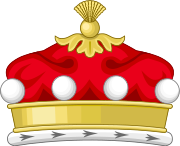Lord of Galloway
This article needs additional citations for verification. (November 2009) |
  |
The lords of Galloway consisted of a dynasty of heirs who were lords (or kings) and ladies who ruled over
The boundaries of the Kingdom of Galloway were ill-defined, and varied over time. During many periods Galloway was much larger than it is today, and took in parts of southern Ayrshire, such as Carrick, Upper Douglasdale and Nithsdale. The area appears to have been the main bastion of Scottish Gaelic culture south of the Highlands in the Middle Ages.
Kingdom of Galloway
Suibne mac Cináeda (d.1034) is the first recorded king of the Gall-ghàidhil, the people of Galloway, although it is not until about 1138 that the succession is properly recorded. The Dynasty of Fergus appears to have continued until 1234 and the Laws of Galloway remained in force until 1426. It is thought that these laws originally derived their authority from the kings of Galloway.
Contrary to some popular conceptions, there is no evidence that Galloway was ever part of the
Magnus III
In the late 11th century, the Norwegian King
On his second campaign, Magnus went to Man, and with a huge fleet attacked Dublin and attempted to force the submission of
Fergusan Dynasty
Lochlann married Helen, the daughter of
Douglas Lords
In 1369,
- Archibald Douglas, Lord of Galloway
- Archibald Douglas Lord of Galloway
- Archibald Douglas, Lord of Galloway
- Margaret Douglas, Fair Maid of Galloway
List of lords of Galloway
| Rulers | French name | Reigns |
|---|---|---|
| ?Suibne | --- | d. 1034 |
| - | --- | - |
| ?Echmarcach | --- | d. 1065 |
| - | --- | - |
| Fergus | --- | d. 1161 |
Uchtred |
--- | 1161–1174 |
Gille Brigte |
Gilbert | 1174–1185 |
Lochlann |
Roland | 1185–1200 |
Alan |
--- | 1200–1234 |
Notes
- .
References
- ^ Scott, JG (1997) pp. 13a fig. 1, 23 fig. 5; Oram, RD (1991) p. 118 fig. 8.1; Barrow (1980) p. 51.
- The Arms of the Realm and Ancient Local Principalities of Scotland, Bartholomew 1983. ISBN 0-7028-1709-0

